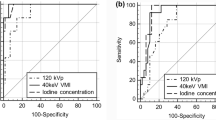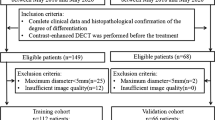Abstract
The objective of our study is to determine whether67Ga SPECT can supplement CT and/or MRI diagnostic information by visual comparison of the two separate data sets in patients with head and neck tumors.Methods: A total of 50 patients with head and neck tumors (benign: 19, malignant: 31) were entered in the study. Three board-certified radiologists who had practical experience in interpreting both head and neck CT/MRI and67Ga SPECT images, participated as readers. All of the CT and/or MR images of each patient were shown to each reader first, who after they had finished interpreting them were shown the67Ga SPECT images. They were asked to score each image on a 7-point scale for the likelihood of the presence or absence of malignancy. Histological or cytological evaluation was done in all cases, and the radiologic studies were correlated with these findings.Results: Improvement of all three readers’ performance was from 70.7% to 83.3% in the mean accuracy and from 0.790 to 0.921 in the mean Az value (p=0.033, 0.163, 0.105 in the Az values) after they were shown the67Ga SPECT images.Conclusions:67Ga SPECT should substantially increase confidence in the diagnosis of head and neck tumors when CT and/or MRI do not permit differentiation between benign and malignant disease.
Similar content being viewed by others
References
Dillehay GL, Papatheofanis F. Gallium imaging of tumors. In: Henkin RE, Boles MA, Dillehay GL, eds.Nuclear Medicine. St. Louis: Mosby-Year Book, Inc., 1996; 1463–1492.
Kostakoglu L, Yeh SDJ, Portlock C, et al. Validation of gallium-67-citrate single photon emission tomography in biopsy-confirmed residual Hodgkin’s disease in the mediastinum.J Nucl Med 1992; 33: 345–350.
Front D, Bar-Shalom R, Mor M, Haim N, Epelbaum R, Frenkel A, et al. Hodgkin disease: prediction of outcome with67Ga scintigraphy after one cycle of chemotherapy.Radiology 1999; 210: 487–491.
Front D, Bar-Shalom R, Mor M, Haim N, Epelbaum R, Frenkel A, et al. Aggressive non-Hodgkin lymphoma: early prediction of outcome with67Ga.Radiology 2000; 214: 253–257.
Murata Y, Ishida R, Umehara I, Ishikawa N, Komatsuzaki A, Kurabayashi T, et al.67Ga whole-body scintigraphy in the evaluation of head and neck squamous cell carcinoma.Nucl Med Commun 1999; 20: 599–607.
Tomura N, Hirano H, Watanabe O, Hirano Y, Kato K, Sasaki K, et al. Comparison of thallium-201 and gallium-67 imaging in evaluation of head and neck tumors.J Comput Assist Tomogra 2000; 24: 454–460.
American Joint Committee on Cancer. Staging of cancers at specific anatomic sites: lip and oral cavity. In: Bearths OH, Henson D, Hutter RVP, Myers MH, eds.Manual for Staging of Cancer, 3rd ed. Philadelphia; Lippincott, 1988; 27–32.
Hanley JA, McNeil. The meaning and use of the area under a receiver operating characteristics (ROC) curve.Radiology 1982; 143: 29–36.
Zbaren P, Becker M, Lang H. Pretherapeutic staging of laryngeal carcinoma: clinical findings, computed tomography, and magnetic resonance imaging compared with histopathology.Cancer 1996; 77: 1263–1273.
Zbaren P, Becker M, Lang H. Pretherapeutic staging of hypopharyngeal carcinoma: clinical findings, computed tomography, and magnetic resonance imaging compared with histopathologic evaluation.Arch Otolaryngol Head Neck Surg 1997; 123: 908–913.
Castelijns JA, Becker M, Hermans R. Impact of cartilage invasion on treatment and prognosis of laryngeal cancer.Eur Radiol 1996; 6: 156–169.
Jabour BA, Choi Y, Hoh CK, Rege SD, Soong JC, Lufkin RB, et al. Extracranial head and neck: PET imaging with 2-[F-18]fluoro-2-deoxy-d-glucose and MR imaging correlation.Radiology 1993; 186: 27–35.
Li P, Zhuang H, Mozley PD, Denittis A, Yeh D, Machtay M, et al. Evaluation of recurrent squamous cell carcinoma of the head and neck with FDG positron emission tomography.Clin Nucl Med 2001; 26: 131–135.
Chisin R, Pietrzyk U, Sichel JY, Rubinstein R, Yaffe S, Bocher M, et al. Registration and display of multi-modal images: applications in the extracranial head and neck region.J Otolaryngol 1993; 22: 214–219.
Treves ST, Mitchell KD, Habboush IH. Three-dimensional image alignment, registration and fusion.J Nucl Med 1998; 42: 83–92.
Bocher M, Balan A, Krausz Y, Shrem Y, Lonn A, Wilk M, et al. Gamma camera-mounted anatomical X-ray tomography: technical, system characteristics and first images.Eur J Nucl Med 2000; 27: 619–627.
Tsan M, Scheffel U. Mechanism of gallium-67 accumulation in tumors.J Nucl Med 1986; 27: 1215–1219.
Vaughan CW, FitzGerald TJ, Vlock D, Vergo TJ Jr, Costello R. Cancer of the head and neck. In: Osteen RT, ed.Cancer Manual 9th ed. Boston; American Cancer Society, 1996: 290–307.
Okumura Y, Takeda Y, Sato S, Komatsu M, Nakagawa T, Akaki S, et al. Comparison of differential diagnostic capabilities of201Tl scintigraphy and fine-needle aspiration of thyroid nodules.J Nucl Med 1999; 40: 1971–1977.
Togawa T, Suzuki A, Kato K, Higuchi Y, Moriya H, Hoshi K, et al. Relationship between201Tl to67Ga uptake ratio and histological type in primary lung cancer.Eur J Cancer and Clinical Oncol 1985; 21: 925–930.
Togawa T, Yui N, Kinoshita F, Koakutsu M, Ishihara M. Tl-201/Ga-67 uptake ratio in lung tumors—comparison between planar and SPECT methods.KAKU IGAKU (Jpn J Nucl Med) 1992; 29: 123–131.
Mukherji SK, Drane WE, Tart RP, Landau S, Mancuso AA. Comparison of thallium-201 and F-18 FDG SPECT uptake in squamous cell carcinoma of the head and neck.AJNR 1994; 15: 1837–1842.
Valdes Olmos RA, Balm AJ, Hilgers FJM, Koops W, Loftus BM, Tan IB, et al. Thallium-201 in the diagnosis of head and neck cancer.J Nucl Med 1997; 38: 873–879.
Nagamachi S, Hoshi H, Jinnouchi S, Ohnishi T, Flores LG, Futami S, et al. Tl-201 SPECT for evaluation for head and neck cancer.Ann Nucl Med 1996; 10: 105–111.
Author information
Authors and Affiliations
Corresponding author
Rights and permissions
About this article
Cite this article
Kosuda, S., Kadota, Y., Umeda, S. et al. Does supplementation of CT and MRI with gallium-67 SPECT improve the differentiation between benign and malignant tumors of the head and neck?. Ann Nucl Med 17, 475–480 (2003). https://doi.org/10.1007/BF03006438
Received:
Accepted:
Issue Date:
DOI: https://doi.org/10.1007/BF03006438




